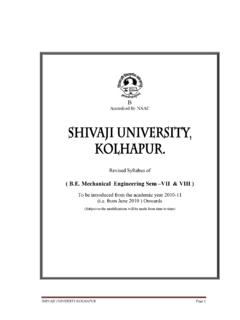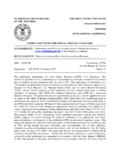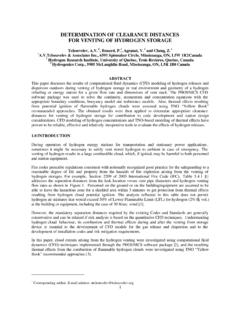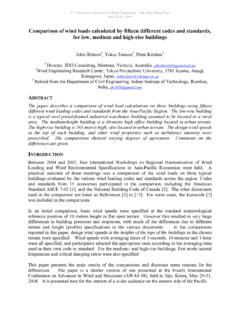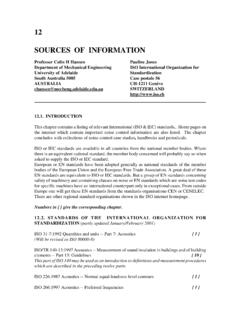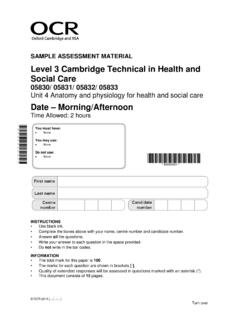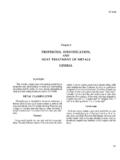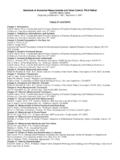Transcription of Facility Condition Assessment Practices - Graphic …
1 COPYRIGHT 2001, Graphic SYSTEMS, INC.; ALL RIGHTS RESERVEDPAGE 1 OF 13 Facility Condition Assessment PracticesEric Teicholz, Alan EdgarABSTRACTF acility Condition Assessment (FCA) is emerging as a powerful executive tool for both strategic capitalplanning and tactical project prioritization. Until recently, FCA systems primarily were static tools forcollecting deficiency information to help manage deferred maintenance backlogs. Little thought wasgiven to the provision of life cycle data and to the integration of FCA information with other FMtechnology systems particularly CMMS and project management software.
2 With the currentfunctionality of many FCA vendors, the usefulness of these systems extends well beyond the simplecollection of static article looks at current FCA capabilities and how to effectively use and maintain FCA data as amajor component of strategic FM AND NEEDMost organizations have significant backlogs of Facility renewal and replacement needs. To get anunderstanding of the extent of the deferred maintenance backlog, organizations will often hire aconsultant to assess the Condition of the Facility , or portfolio of facilities, and generate a report ofdeficiencies and corrections.
3 If the building portfolio is large or disbursed, the organization will oftenengage multiple consultants to perform the inspection audit. The result is usually a report of findingsconsisting of deficiencies and correction data to aid the client in prioritizing problems and helpingdetermine deferred maintenance limitations of such an approach include: The data is obsolete as soon as it is collected; Life cycle information is not collected;COPYRIGHT 2001, Graphic SYSTEMS, INC.; ALL RIGHTS RESERVEDPAGE 2 OF 13 Quality control for large portfolios is a problem since data collection is often inconsistentbetween consultants; The FCA data is not integrated with other enterprise financial and FM systems.
4 No benchmark information was derived from the data the increasing awareness that physical infrastructure greatly effects worker performance andproductivity, the need to better financially manage this infrastructure, and increased regulatoryreporting requirements, organizations are increasingly turning to sophisticated technology to helpmanage facilities of the more powerful incentives for using computer based tools for portfolio management is theresult of a recent Government Accounting Standards Board (GASB) statement (particularly statement35) requiring detailed information about the Condition and stewardship of government buildingsstarting in June 2002.
5 Information associated with existing conditions of buildings maintained alongwith costs associated with maintaining the infrastructure at an established level over time will berequired in a pre-established format. The advantages for the client (in this case any local governmentwith total annual revenues of over $100 million) are significant and it will be only a matter of timebefore other organizations (both public and private) require such such FCA data is available on a regular and on-going basis, it is possible to use this informationin a strategic manner to help determine alternative funding strategies for short and long range 1 below, from the National Association of College and University Business Officers (NACUBO)
6 1991 report Managing The Facilities Portfolio: A Practical Approach to Institutional Facility Renewaland Deferred Maintenance (Applied Management Engineering, Virginia Beach, VA), illustrates anoverview of such a facilities portfolio management 2001, Graphic SYSTEMS, INC.; ALL RIGHTS RESERVEDPAGE 3 OF 13 Figure 1: An Overview of the Facilities Portfolio Management Model(from NACUBO s Managing the Facilities Portfolio)THE FCA PROCESS1. Baseline Data: The planning process begins with a building inspection that includes thedetermination of what data needs to be collected (see figure 1 above).
7 FCA data can be quiteflexible in its determination and include not only physical systems (architectural, civil/mechanical,electrical, other engineering systems, underground facilities, physical infrastructure, etc.) but includeother parameters associated with space utilization, air quality, code compliance issues and even theconsideration of esthetic for the inspection involves, for example, the determination of what systems need to beinspected, what priorities are to be assigned for maintenance and renewal deficiencies, what dataassociated with preventive maintenance needs to be collected for equipment, whether life/safetyinformation is to be collected, types of standards and coding schemas that are to be applied, howCOPYRIGHT 2001.
8 Graphic SYSTEMS, INC.; ALL RIGHTS RESERVEDPAGE 4 OF 13cost correction data bases for deficiencies are to be used, whether space utilization data is to becollected, and so a minimum, NACUBO recommends that the following data be collected: Building number/name; Gross square footage; Date of construction; Type of construction; Functional use; Number of floors; Current replacement Inspection Team and Inspection: The inspection team must obviously reflect the skill sets of the baselinedata requirements being collected. For large projects, or for geographically disbursed buildings,multiple teams might be deployed.
9 The teams can be in-house or outsourced there are advantagesand disadvantages to both. If outsourced, care must be taken to insure data consistency particularly if multiple teams are deployed, even from the same outsourcing group. Teams mustwork with the client to review procedures, priorities, standards and other data. Correctioninformation must be determined. Judgments regarding whether entire systems or components ofsystems need to be determined. Source data ( , floor plans, craft codes, local labor rates, contactinformation, safety precautions if required, historical data) must be gathered and calendarschedules for inspections determined.
10 Deficiency information must be described during theinspection along with locational information, priority, type, corrective information (including craftrequired to perform the corrective action, quantity and timing data) and other details that willenable cost estimates (including labor and material information) to be generated for Analysis and Reporting: Once FCA data has been collected and analyzed, the types of analysis that canbe performed, is considerable. Figure 2 below depicts deficiencies summarized by category andcorrection costs (in this case using Means data for labor and material cost calculations):COPYRIGHT 2001, Graphic SYSTEMS, INC.
